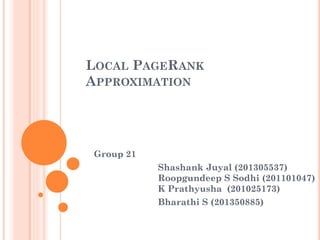
Local Approximation of PageRank
- 1. LOCAL PAGERANK APPROXIMATION Group 21 Shashank Juyal (201305537) Roopgundeep S Sodhi (201101047) K Prathyusha (201025173) Bharathi S (201350885)
- 2. CONTENT What is PageRank? Objective PageRank for whole Dataset Local Approximation of PageRank Experiments and Results Challenges and Issues Conclusion and Future Scope References
- 3. WHAT IS PAGERANK? Named after Larry Page, cofounder of Google PageRank is an algorithm used by Google Search to rank websites in their search engine results. Way of measuring the importance of website pages Works by counting the number and quality of links to a page to determine a rough estimate of how important the website is.
- 4. OBJECTIVE In General, for PageRank calculation, a global computation is needed But there are situations in which PageRank scores are required for just a small subset of the nodes. Suppose a web site owner want to promote his website in search engine rankings in order to attract traffic of potential clients. So he is interested only in the PageRank score of his own website but not in the PageRank scores of all other web pages.
- 5. OBJECTIVE Global PageRank computation for the entire web graph is out of the question for most users, as it requires significant resources and knowhow. That is why Local Approximation of Page-Rank is required.
- 6. PAGERANK FOR WHOLE DATASET We traversed through the dataset and applied the algorithm proposed by Page and Brin on the set directly. 1. In that approach, Page Rank for each page is calculated based on the back links which are pointing to that page. 2. A given Page-Rank value of a page is equally divided among the forward-links of that page. The page to which it has pointed will use that value to calculate its own page rank. 3. Additional factor has also to be considered which will make sure that the page-rank algorithm converges (especially in cases where loops are present).
- 7. PAGERANK FOR WHOLE DATASET Algorithm (Proposed by Larry Page and Sergie Brin ) Where, -PR(X) is the PageRank of page X, initial value of 1 -PR(Ti) is the PageRank of pages Ti which link to page A, -C(Ti) is the number of backward links on page Ti and -d is a damping factor which can be set between 0 & 1. Iterate over pages Calculate for each page PR(X) = (1-d) + d ( PR(T1) / C(T1) + ... + PR(Tn) / C(Tn)) Till PR(X-1)=PR(X) for all pages
- 8. LOCAL PAGERANK APPROXIMATION Given a node (page), we have to calculate the approximate page rank: The Algorithm crawls the sub-graph of radius r around the given node (page) “backwards” in BFS order. For each node (page) v at layer t, the algorithm calculates the influence of v on given node at radius t. It sums up the influence values, weighted by some factor. For that the algorithm uses the recursive property of influence: the influence of v on given node at radius t equals the average influence of the out-neighbours of v on given node at radius t−1.
- 9. LOCAL PAGERANK APPROXIMATION Now we can have two approaches to consider the value 'r‘ 1. Run the algorithm with r, which is guaranteed to be an upper bound 2. Run the algorithm without knowing r a priori, and stop the algorithm whenever we notice that the value of Page-Rank does not change by much.
- 10. EXPERIMENTS AND RESULTS 1. Error Percentage for different pageids and radius values
- 11. EXPERIMENTS AND RESULTS 2. Time taken by local approximation for different pageids and radius values
- 12. CHALLENGES AND ISSUES Loading small indexes into memory created problem. But we resolved it by increasing the heap size allocated for the Virtual Machine Deciding the threshold value during the implementation of pruning. There is no unique value for threshold as it varies widely for different PageRank values. Choose wisely !!
- 13. CONCLUSIONS AND FUTURE SCOPE Normal Procedure to calculate PageRank consider whole DataSet for its computation which is time and resource consuming and also not feasible in most of the situations. So Local approximation of PageRank can be predicted by just calculating PageRank over nodes in a smaller graph without calculating PageRank for all the nodes in the dataset The results obtained are very near to the original PageRank results with the average error rate of 15 -20 %.
- 14. CONCLUSIONS AND FUTURE SCOPE The implementation of algorithm and the correctness of the value depend upon the radius defined for the smaller graph. Smaller the radius, higher the error rate and vice versa. But on increasing the radius, the complexity increases exponentially as the number of in links we have to deal with becomes very large. Generally a value of r=3-4 is taken. Pruning techniques can be used to increase the value of r in which the procedure removes all nodes whose influence is below some threshold value T from layer r.
- 15. REFERENCES Ziv Bar-Yossef, Li-Tal Mashiach, and Google Haifa Engineering Center, Haifa, Israel, Local Approximation of PageRank and Reverse PageRank, October 26–30, 2008, ACM 978-1-59593-991-3/08/10 Lawrence Page, Sergey Brin, Rajeev Motwani, Terry Winograd, The PageRank Citation Ranking: Bringing Order to the Web, January 29, 1998, Stanford InfoLab Yen-Yu Chen, Qingquin Gan, Torsten Suel, Local Methods for Estimating PageRank Values, November 8-13, 2004, CIKM’04